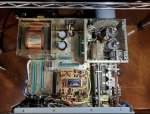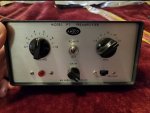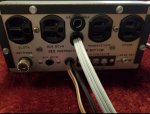Good morning Jacob,
That is a clue. Now to determine if the pulse is over the air via antennas/proximity or via the power lines by a noise pulse. Is the transmitter momentarily keying when you rotate the mode knob to AM? Do you see a noise spike on the AC power line (if you have an oscilloscope or some way of detecting the spike)? Obviously, systematic troubleshooting is going to be required. What test equipment might you have or could you take the transceiver to a friend’s house that has test equipment?
Keep us posted. Have a great weekend!
73, Dave K4EET
Good Morning Dave,
I'm dragging butt a bit today but I've made some significant progress since my last post.
Muting Receiver:
You can indeed mute a second receiver with the ACC plug connection at pins 8 and 9. If you are also running an amplifier you might have a problem with an older amp like the SB-230 that has high voltage at the relay connection as these pins are also used to key the amplifier. I have an external soft key that I tried installing between the FT-101E and the amp in hopes of isolating the amp without success. This "trial and error" was done prior to me correcting the meter spike which I'll talk about later. I have an Ameco PT-1 that I was going to try to use but it seemed to amplify the speaker pops I was having in the Yaesu (keying and unkeying) as well as buzzing that occurred in the receiver when the muting function on the Ameco was used. This is why I initially looked to use the FT-101E directly with the FRG-7.
Meter spike/pulse:
The other scenario I was having was a massive spike that would occur when you would unkey or even when switching between AM and the other modes. This spike would also be accompanied by a loud pop in the speakers of both the FT-101E as well as the FRG-7... even when the later wasn't connected. There is a mod to the PCB 1183 that is discussed in the service manual that requires adding a ceramic and electrolytic cap to the board and removing an electrolytic from the underside of the PCB socket. Unfortunately this had no affect on either the pop or the meter spike. I tried reseating all of the boards as well with no luck.
At this point, with very few options left, I decided to pull all of the boards and try cleaning the board fingers and sockets with DeoxIT...again. I did this when I first acquired the radio 7 months ago but figured screw it.... what do I have to lose? I took a small paint brush and "painted" the sockets with DeoxIT and then sprayed and wiped the board fingers. I then took card stock and ran it in and out of the sockets. I did get some black on some of them. I'm not sure if it is carbon build up, dust, combo etc but apparently my initial cleaning wasn't as thourough as it could have been. For anyone trying to clean the sockets just know that soaking the card stock in DeoxIT doesn't work as it loses its regidity.
I hooked the Yaesu back up and low and behold no meter spike when unkeying. The spike when switching modes was also significantly reduced along with the pop it produces. If you rotate the mode knob slowly it almost eliminates it entirely. I'd removed the cable that I'd connected to the ACC port for the receiver by this point so to save me some time I connected the FT-101E and the FRG-7 to the Ameco PT-1. Everything worked just as it should minus a small pop upon key up that's heard in both the FT-101E speaker as well as the FRG-7 speaker. Other than the 4PDT relay in the Ameco the two units share no connections. I'm going to try disconnecting the muting cables from the FRG-7 today to see if the pop upon key up is still heard. If so the FRG-7 is picking up that pop from the FT-101E. This occurs even if no carrier or gain is used so it's simply the actuation of the relay causing it.
The last step was to introduce the amp back into the equation. I decided to add the soft key between the amp and the PT-1 just for the hell of it. As of last night at 2am everything appeared to work properly save the small speaker pop in both the FT-101E and FRG-7 upon key up. I decided to reverse the mod that was done to the PCB 1183 to see what would happen. Well I can tell you that the mod does work! A very substantial pop returned after reversing it so I reinstalled the mod and that's where I left it as of 3am last night. Some more thorough testing needs to be done today to verify my findings are consistent and not a fluke as I was fried by 3 am. I have a spare set of relays that I might throw at it for the hell of it to see if I can kill the speaker pop on key up. If I can't I'll have to live with it as I'm out of possibilities unless someone has any recommendations.
Unfortunately I can't confirm if muting the receiver directly with the the FT-101e while using an amp will work successfully but it very well might.
I hope you have a great weekend too Dave. Thanks for the help!
Jacob






